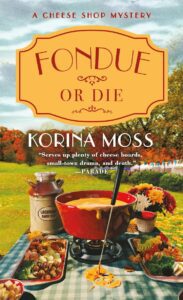 My number one reminder when writing a cozy? Keep it cozy. It must have a comforting feeling, much like a cup of tea, a warm blanket, a good book, or a relaxing dinner with friends. In fact, one of the main reasons readers say they return to a series is because the characters feel like old friends. The town should be almost idyllic… except for those pesky murders, and there should be just enough tension to keep the pages turning, without overly dark themes. In other words, keep it cozy.
My number one reminder when writing a cozy? Keep it cozy. It must have a comforting feeling, much like a cup of tea, a warm blanket, a good book, or a relaxing dinner with friends. In fact, one of the main reasons readers say they return to a series is because the characters feel like old friends. The town should be almost idyllic… except for those pesky murders, and there should be just enough tension to keep the pages turning, without overly dark themes. In other words, keep it cozy.
But it wouldn’t be a mystery without a murder, and there isn’t a murder without an antagonist. A cozy should have at least five suspects, one of them being the culprit. So how do I write realistic suspects and antagonists without straying too far from my number one reminder? I dismiss the idea of a villain.
Every suspect does not have to be mean, unlikable, or argumentative. In fact, it’s better (read: cozier) if they’re not. Who wants to read a cozy mystery with a bunch of characters they don’t like? Besides, in a cozy, you don’t know a bad guy is the bad guy until the final reveal. Which means you’re forced to make your bad guy three-dimensional , just like your likable main characters. The best way to do this is to do an exercise I call, Let Me Tell You My Story.
, just like your likable main characters. The best way to do this is to do an exercise I call, Let Me Tell You My Story.
To do this, you free write as your antagonist (from his point of view) for five to ten minutes. This is after you’ve done his backstory and know something about him. In this exercise, put him in a situation where he must react to something, and dig into how he feels. Remember, this is only for you, not intended to be polished or witty or grammatically correct. This is not just an exercise in writing first person. You must get out of your narrator’s head and into your antagonist’s heart.
Because the thing is, nobody sees themselves as the bad guy (except for maybe a Marvel villain). Even negative emotions—anger, jealousy, greed—come from a vulnerable place—hurt, fear, or scarcity. Conversely, your antagonist can also have a positive trait, that when magnified, becomes negative.
Once you dig deeper to find the emotion that’s the driving force of your antagonist, you reveal it in subtle ways throughout the book. For example, you can show your culprit as a loyal friend, and then incorporate subtle signs throughout the book that speak to their loyalty, which cause no red flags for the reader. However, that loyalty, magnified, is the driving force that leads them to protect or avenge through murder the person they were loyal to. Therefore, when your loyal antagonist is revealed as the murderer, it's a believable surprise, because their personality tracked with their motivation as the killer. Thus, writing a three-dimensional antagonist can make for an equally satisfying conclusion for the reader.
 KORINA MOSS is the author of the Cheese Shop Mystery series set in the Sonoma Valley, including the Agatha Award winner for Best First Novel, Cheddar Off Dead and the Agatha Award finalist for Best Contemporary Novel, Case of the Bleus. Her books have been featured in USA Today, PARADE Magazine, Woman’s World, AARP, and Fresh Fiction. To learn more or subscribe to her free monthly #teamcheese newsletter, visit her website, and follow her on Facebook and Instagram.
KORINA MOSS is the author of the Cheese Shop Mystery series set in the Sonoma Valley, including the Agatha Award winner for Best First Novel, Cheddar Off Dead and the Agatha Award finalist for Best Contemporary Novel, Case of the Bleus. Her books have been featured in USA Today, PARADE Magazine, Woman’s World, AARP, and Fresh Fiction. To learn more or subscribe to her free monthly #teamcheese newsletter, visit her website, and follow her on Facebook and Instagram.
Website: korinamossauthor.com
Facebook: facebook.com/korinamossauthor/
Instagram: instagram.com/korinamossauthor/

Great advice and a wonderful post!
Thanks for stopping by… and I agree that Korina’s post is right on point.
Thank you, Mally!
Great post. Antagonists in cozy mysteries are rarely bad people. It’s usually someone who’s acting out of desperation.
Agreed! Thank you!
Kathleen,
You are so right! Thanks for stopping by today.
Not a writer but a reader and this post was right on target.
Thank you, Nancy!
Appreciate your comments especially since if the writer succeeds, it is because the reader reacts in the way that Korina has outlined.
Nobody’s all bad or all good. Thanks for this stellar advice.